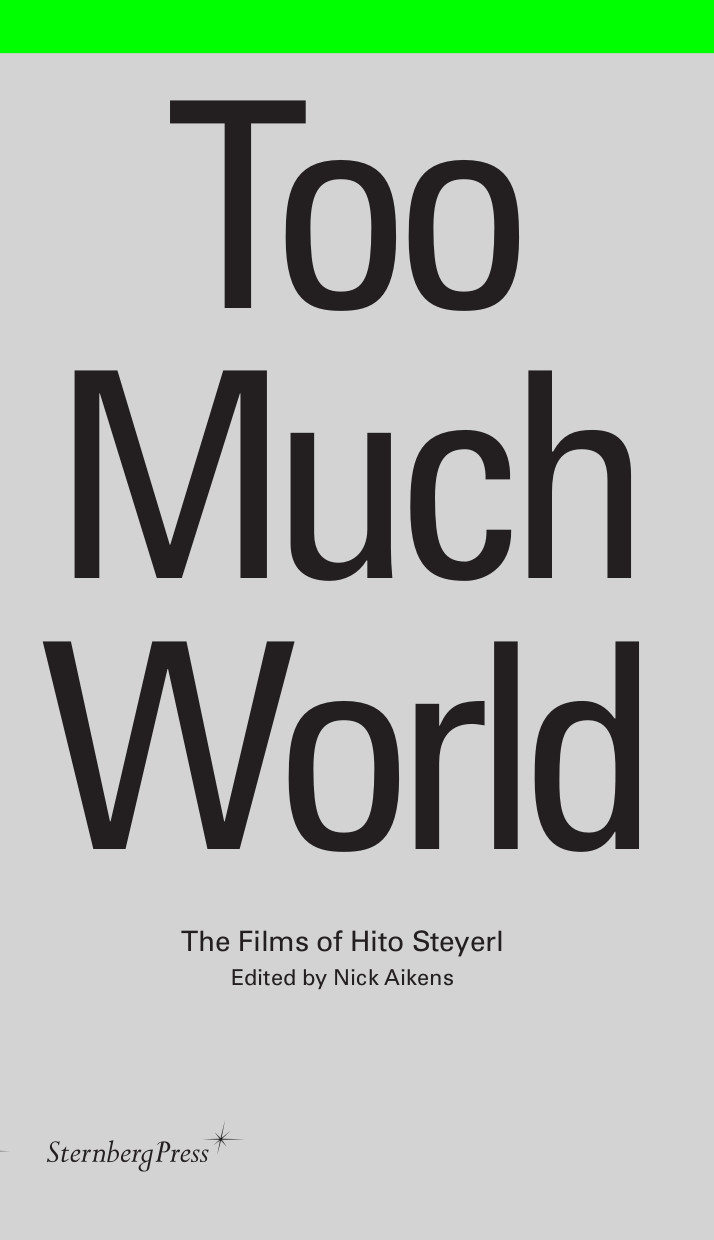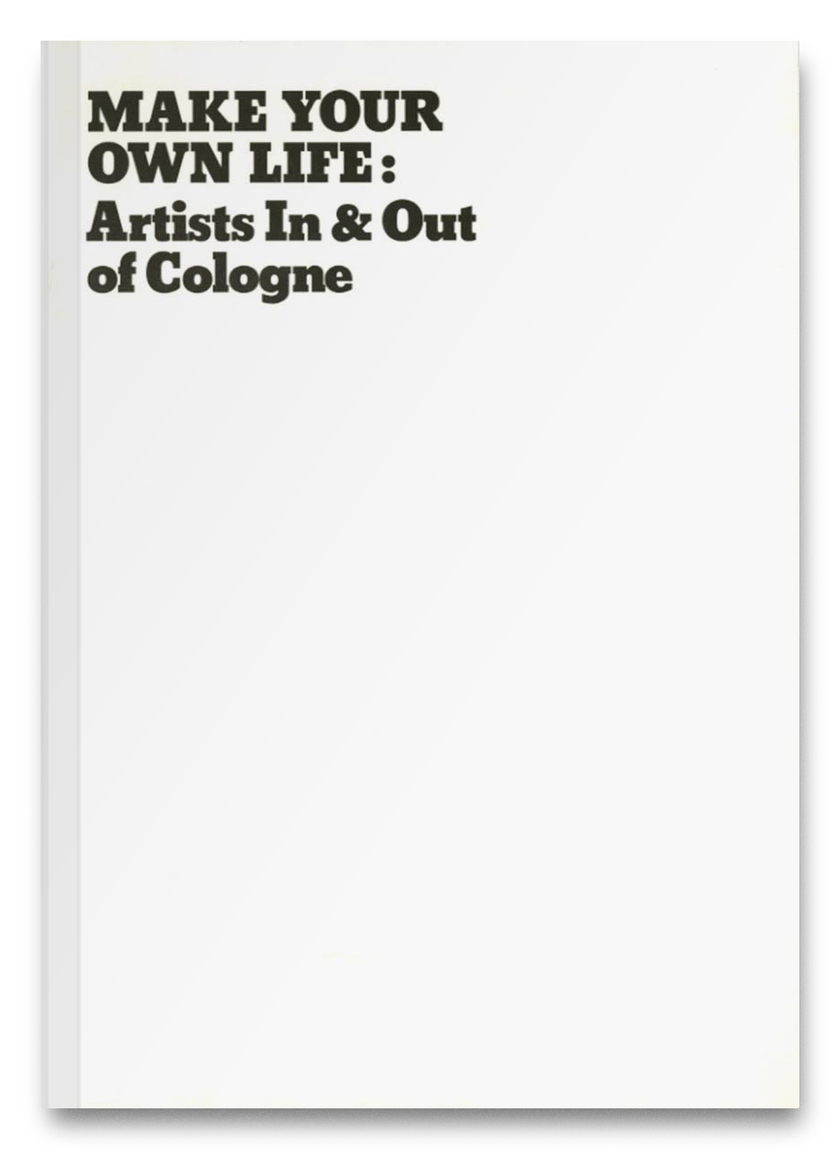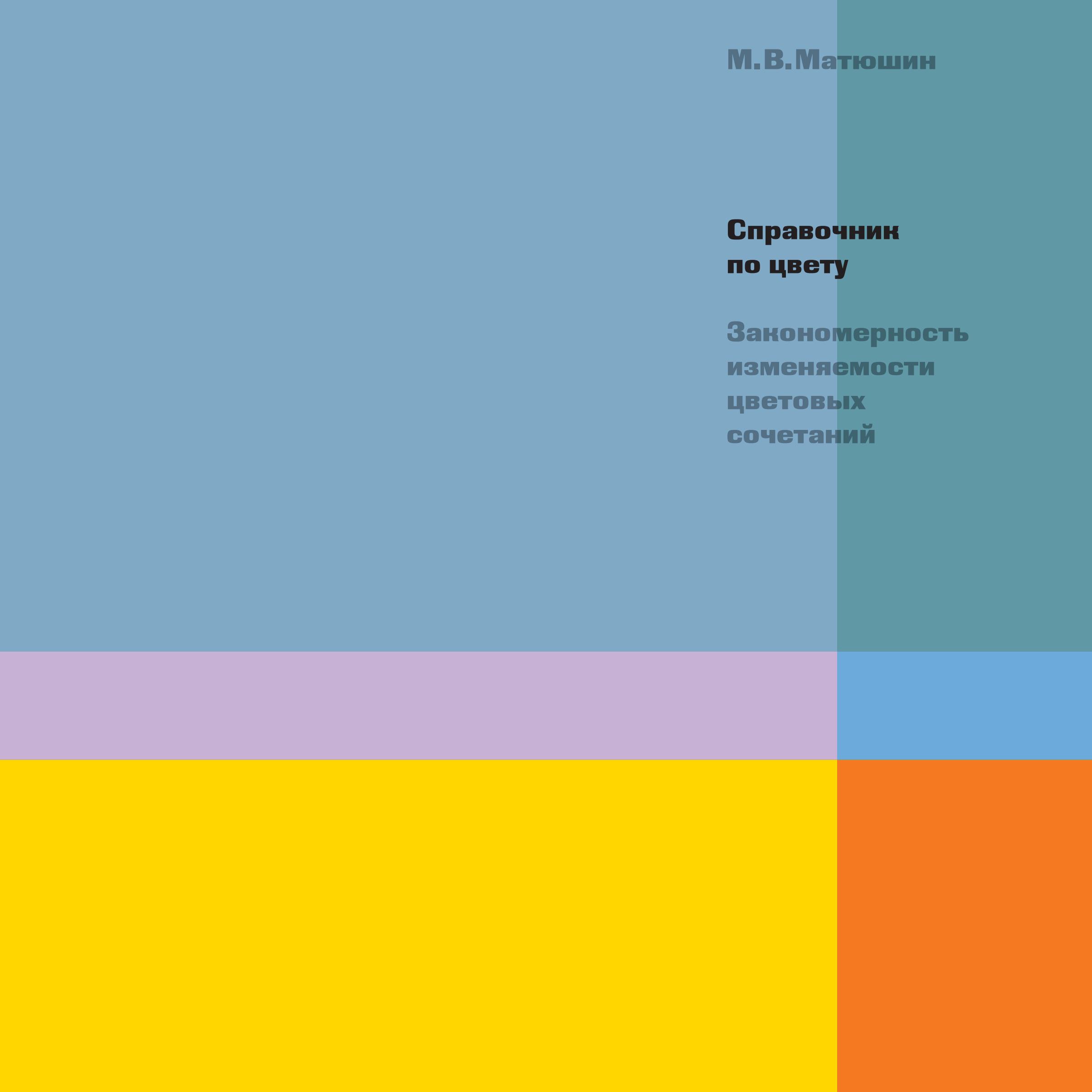Too Much World: The Films of Hito Steyerl (2014)
Filed under book | Tags: · art, art criticism, cinema, film, film criticism, image, internet, politics, theory

“Hito Steyerl is considered one of the most exciting artists working today who speculates on the impact of the Internet and digitization on the fabric of our everyday lives. Her films and writings offer an astute, provocative, and often funny analysis of the dizzying speed with which images and data are reconfigured, altered, and dispersed, many times over, accelerating into infinity or crashing into oblivion.
Published to accompany the artist’s survey exhibitions at the Van Abbemuseum, Eindhoven, and the Institute of Modern Art, Brisbane, Too Much World gathers a series of essays and close readings of Steyerl’s films from 2004-2014. Newly commissioned texts by Sven Lütticken, Karen Archey, Ana Teixeira Pinto, and Nick Aikens, alongside writings by Thomas Elsaesser, Pablo Lafuente, David Riff, and Steyerl, are spliced with over one hundred pages of color stills.”
Edited by Nick Aikens
Publisher Sternberg Press, Berlin; Van Abbemuseum, Eindhoven; and Institute of Modern Art, Brisbane, 2014
Creative Commons BY-NC-SA 4.0 International License
ISBN 9783956790577
247 pages
Exh. reviews: Amelia Groom (2014), Paula Albuquerque (Necsus 2015), Dylan Rainforth (LEAP 2015), Kate Woodcroft (Artlink 2015), Scott Redford (Ran Dian 2015).
Exhibition (Van Abbemuseum)
Exhibition (IMA)
Publisher (Sternberg)
WorldCat
PDF, PDF (single pages, 4 MB)
PDF, PDF (spreads, 4 MB)
Make Your Own Life: Artists In & Out of Cologne (2006)
Filed under catalogue | Tags: · 1980s, 1990s, art, art history

“Catalogue for the 2006 exhibition curated by Bennett Simpson at the ICA Philadelphia, which brought together over 25 artists of three generations—centering from Cologne but also including Los Angeles, New York, London, and Berlin—to explore themes of autonomy, artistic collectivity and social relationships, and the privileging of the artist’s life and context as a basis for understanding creative practice.
In the 1980s and early-90s, the German city of Cologne was one of the most important centers for contemporary art in Europe, if not the world. With its many galleries, artist run-spaces, and artist bars, the city assumed a kind of mythological dimension, a place where artists came to show, sell, socialize, and distinguish themselves and their work on levels symbolic and real. The open question of how one makes one’s art in relation to a set of communities, histories, market conditions and social attitudes was at the core of the Cologne scene. It was fiercely debated, dramatized in exaggerated behavior, art works and exhibitions alike, and it contributed greatly to the impression that Cologne was a place of extreme self-consciousness and audacity.”
Artists: Bernadette Corporation, Cosima von Bonin, Merlin Carpenter, Stephan Dillemuth, Michaela Eichwald, Andrea Fraser, Kim Gordon, Charline von Heyl, Gareth James, Mike Kelley, Martin Kippenberger, Jutta Koether, Michael Krebber, Louise Lawler, Hans-Jorg Mayer, Lucy McKenzie, Nils Norman, Albert Oehlen, Christian Philipp Muller, Stephen Prina, Josephine Pryde, Blake Rayne, Reena Spaulings, Josef Strau, Rosemarie Trockel, Filmgruppe West, Christopher Williams, and Christopher Wool, a.o.
Edited by Jenelle Porter
Publisher Institute of Contemporary Art, Philadelphia, 2006
ISBN 0884541088
96 pages
via ICA Phil
Exh. review: Christian Rattemeyer (Artforum).
PDF (18 MB)
Comment (0)Mikhail Matiushin: Colour Handbook (1932/2007) [Russian]
Filed under book | Tags: · avant-garde, colour, perception, theory

Mikhail Matiushin (1861-1934), a Russian composer and painter, studied physiology of human senses and developed his own concept of the fourth dimension connecting visual and musical arts, a theory that he put to practice in the classrooms of Leningrad Workshop of SVOMAS and GINKhUK (1918–1934) and summarized in his work 1932 Spravochnik po tsvetu [Colour Handbook].
“In Leningrad in the 1920s intensive colour research was made at GINKhUK “State Institute of Artistic Culture” where Kazimir Malevich was headmaster. In the ‘laboratories’ of form and colour a foundation for a union of art, science and practical application was developed. The ‘Department of Organic Culture’ was supervised by Matiushin.
By some miracle or oversight, Matiushin’s Colour Handbook passed censorship. Four hundred copies were published in Moscow and Leningrad in 1932, the same year that the Central Committee of the Communist Party took measures to centralise all art organisations. With Marxist-Leninist materialism as the only accepted method, Matiushin was obliged to express himself in terms of physics, physiology and chemical processes in the body in order to be politically accepted.
The fundamental concepts of Matiushin’s theory were ‘Organic Culture’ and ‘Spatial Realism’, which were also the names of the workshops he supervised as a ‘red professor’. Here Matiushin developed a training programme together with his students, including yoga, meditation and various exercises conceived to ‘create and develop the artist’. These new physical possibilities of perception were called ‘extended’ or ‘amplified vision’ which did not only include the eyes, but was expanded to involve hearing, tactility, and thinking – in short, a kind of conscious synaesthesia.
With a panoramic visual angle of 360° producing a new spatial reality of the fourth dimension, colours would emerge more intensely than in our normal, physical world. With untrained eyes a stone, for example, would seem ‘dead’, immobile, static. In the fourth dimension, however, it should be possible to see the low frequency waves of solid materials such as stones and minerals. With cars at one speed, people at another, trees growing at yet a third speed, to the untrained eye, the world seems scattered and fragmented. For those who could apply the extended vision however, the whole world would, from an ontological perspective, appear completely different, with all links and connections organically unified.
The Handbook is illustrated with thirty, handmade colour charts, each of them showing a combination of three different colours. Perception of the interconnection between colours was stressed rather than individual colours in isolation.
The book was but a small percentage of the work on colour vision Matiushin produced during his lifetime. After his death, his findings were stored away in archives and were largely forgotten as a result of the political circumstances in which they were conceived.” (Margareta Tillberg, 2001)
An English translation under the title “The Laws Governing the Variability of Colour Combinations: Colour Manual” appeared in Margareta Tillberg’s book Coloured Universe and the Russian Avant-Garde. Matiushin on Colour Vision in Stalin’s Russia, 1932, Stockholm University, 2003, pp 345-376.
Справочник по цвету. Закономерность изменяемости цветовых сочетаний
First published in Moscow/Leningrad, 1932
New edition D. Aronov, Moscow, 2007
ISBN 9785940560164
72 pages
via Tehne.com
Commentary: Bulat Galeyev (Leonardo, 2005).
Comment (0)
